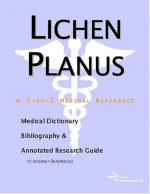|
This section contains 387 words (approx. 2 pages at 300 words per page) |
Lichen planus is a skin rash characterized by small, flat-topped, itchy purplish raised spots on the wrists, arms, or lower legs. Although the evidence is not conclusive, many researchers assert that Lichen planus is an autoimmune disease.
Lichen planus affects approximately one to two percent of the population. Although there is no apparent correlation to race or geographic region, it is interesting to note that the majority of individuals affected are women, age 30 to 50 years. Lichen planus rashes may produce discoloration of the skin, especially in darker skinned population groups. Lichen planus lesions may develop on the genitals or in the mouth. Within a few years, most of the spots disappear, even without treatment.
Although not definitive, researchers assert Lichen planus exhibits many of the characteristics of an autoimmune disorder. Autoimmune diseases result when the immune system attacks the body's own cells, causing tissue destruction. Dermatologists argue that the condition may result from a viral infection that is then aggravated by stress. Lichen planus symptoms are similar to allergic reactions to arsenic, gold, and bismuth. The spots are also similar to the type produced from allergic reactions to certain chemicals used to develop film.
There is a correlation (a statistical relationship) between allergic reactions to certain medications and the appearance of a Lichen planus rash in the mouth. Oral lichen planus usually forms white lines and spots that may appear in clusters. Only a definitive biopsy can fully distinguish the rash from yeast infections or canker sores. Dentists find that some patients develop a Lichen planus rash following dental procedures. Other reports indicate that a Lichen planus rash may appear as an allergic-reaction like response to certain foods, candy, or chewing gum.
Because the exact cause of Lichen planus is unknown, there is no specific treatment for the rash. Treatment with various combinations of steroid creams, oral corticosteroids, and oral antihistamines appears effective at relieving discomfort caused by the rash. In more severe cases PUVA photochemotherapy, a procedure where cells are photosensitizing and then exposed to ultraviolet light and antibiotics.
Lichen planus may also affect the growth of nails and, if present on the scalp, may contribute to hair loss.
Lichen planus is not an infectious disease. Research also indicates that it is not, as once argued, caused by any specific dietary deficiency.
|
This section contains 387 words (approx. 2 pages at 300 words per page) |


